The “Dogs” are Barking for Attention
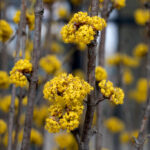
Cornus (Dogwood) is not a species of plant that we put much thought into. Most of them sit in the background being the workhorses they are. Cornus are one the of the few species that cover all “types” of plants. From the 3” perennial Cornus canadensis (“Bunchberry”) to the shrubby ‘Ivory Halo’ types (many of them natives) to multiple sizes of ornamental trees which also include many natives.
Let’s start with humble Cornus sericea and its cultivars, the “Redtwig’ and “Yellowtwig” dogwoods. We’ll cover the natives first, then cultivars.
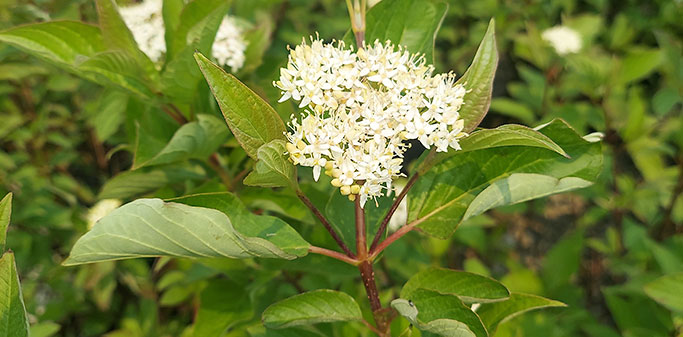
Cornus Baileyi
C s. Baileyi… Wait, I said natives first!!! And ‘Baileyi’s’ gets included in with the natives. Unlike its cousins ‘Bergessons’, ‘Kelsy’ etc., ‘Baileyi’ is a naturally occurring hybrid that was found on the side of the road in Minnesota by a worker from Bailey Nursery. Yes, officially ‘Baileyi’ are considered a cultivar (scientifically speaking) but because it is a naturally occurring hybrid it is usually ok to swap for straight Cornus sericea. The straight species, ‘Baileyi’, and all the other cultivars of Cornus sericea like wet to swampish locations and have a vase-shaped habit. What is the difference? ‘Baileyi’ has a deeper red color in the winter! That is it! …officially
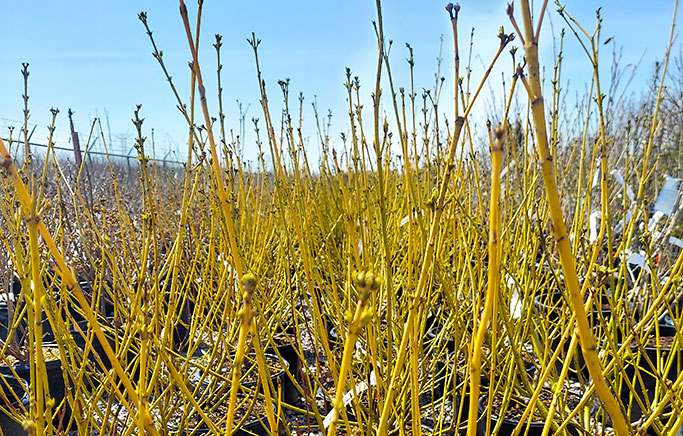
Buds Yellow Cornus sericea
Unofficially, there is another problem. I can get you #3 or #5 Cornus s. ‘Baileyi’ all day long. Nice full plants, foliage fairly clean, well maintained, and pruned accordingly for success. However, to get a native Cornus sericea, I have to go to smaller nurseries that specialize in native material. Typically, straight Cornus sericea is available in a #2 or #3 pot with a couple of sticks sticking out of the pot in all directions. It’s hard for me to sell, and more importantly, really hard for you to sell. I understand and you do also, but know that if you want straight species, I am going to sell it to you – only because even though it may be 2 sticks in a pot it is rock solid hardy, and will grow up to be a nice 7-9’ tall plant. It just doesn’t start as pretty as ‘Baileyi’ or any other cultivars.
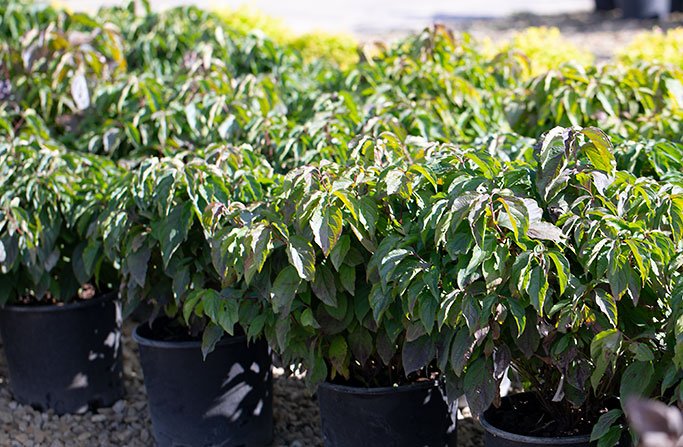
Cornus sericea 'Kelsy'
Other sericea that are noteworthy are:
- ‘Kelsy’ A cute little mound of green leaves and bright red stems growing 2-3’ x 2-3’.
- ‘Buds Yellow’ is an older cultivar but a well-established “Yellowtwig” that is 5-7’ tall with a vase shaped habit.
- ‘Bergessons Compact’ grows 4-5’ x 4-5’ with dark red stems.
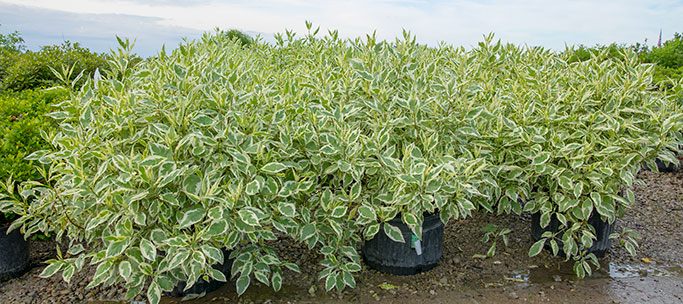
Cornus Alba 'Ivory Halo'
Very closely related is Cornus alba ‘Ivory Halo’ or tartarian dogwood. These are not as aggressive as Cornus sericea cultivars can be. The stems get red but not as red as the “Redtwigs”, but the green and white variegated leaves are where it is at!
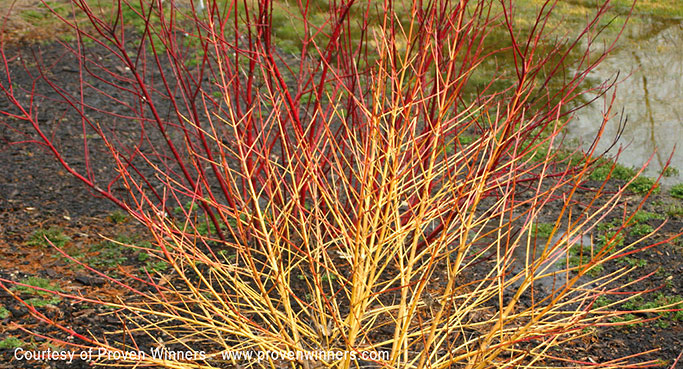
Cornus sanguinea 'Arctic Sun'
Another closely related species is C. sanguinea “Bloodstems”. Proven Winners® have some newer ones that are just starting to hit the market in quantities. We had a few here last year, but we will see more this year. ‘Arctic Fire’, ‘Arctic Fire Yellow’, and ‘Arctic Fire Sun’ all have a nice, rounded habit, get 3-4’ x 3-4’, and have bright red (or yellow) stems.
There are many others on the market these days. Many are native to us or other parts of the states. We have our favorites and they have theirs.
Before I go, I would like to go back to the natives for a minute.
- Cornus racemosa “Grey dog’” prefers a swampy area and will reach 10’ tall. It has red stems but not a great color.
- C. amomum “Silky dog”. It really has no stem color and like the “Grey dogs” like a wet swampy area. “Silky’s” have a nice, rounded habit.
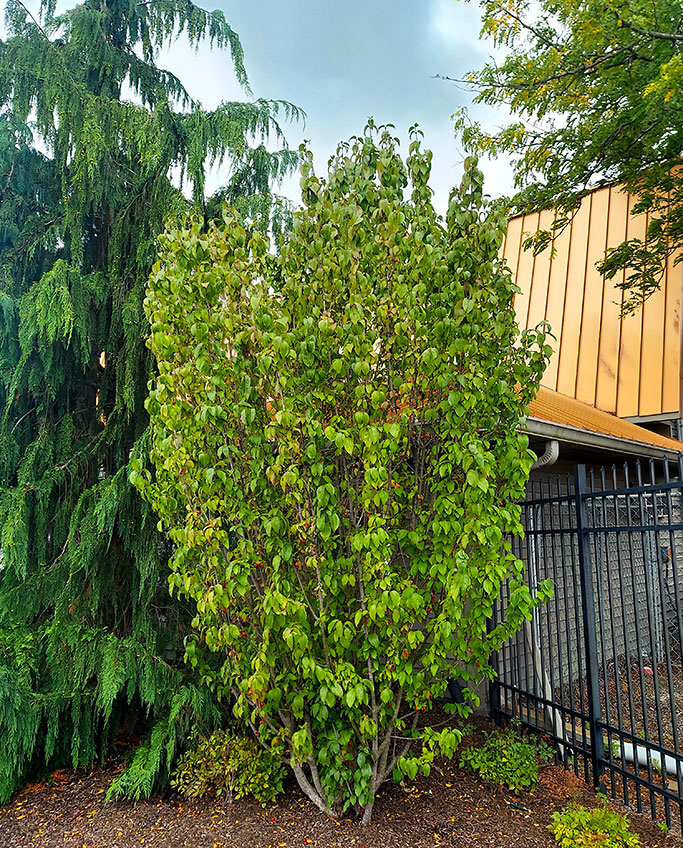
Cornus mas Golden Glory
There is one more Cornus I would like to add to this list. Not a shrub but maybe a small tree. Cornus mas 'Golden Glory'. These fit into the world of Amelanchier and some ‘Crabs’ as an understory tree. They will be about 15-25’ tall and 10-15’ wide. They flower yellow in the early spring which is followed by a cherry-red berry. They can be treeform or shrubby form (my favorite). Want to know what they look like, come on over to the west side of the nursery and look at the front landscape. I didn’t have room at home, so I made them plant one here for me to look at!
No matter what Cornus you and your customers choose, I get people what they want. Sometimes it’s an alphabetical list; sometimes a vision! Either way, I’m here for you.
Ps: There is a rather large elephant in the room while I talk about Shrubby Cornus. All “dogs” from the perennials to the trees have fungal leaf spot issues! Less sun, water on leaves, and tight space only exacerbate the issues.
